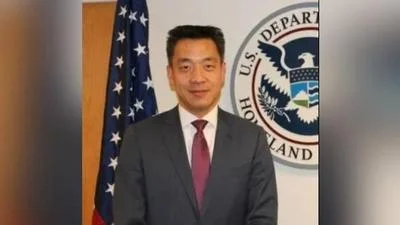Chris Van Hollen | Official U.S. Senate headshot
Chris Van Hollen | Official U.S. Senate headshot
On July 06, U.S. Senators Chris Van Hollen (D-Md.), a member of the Senate Foreign Relations Committee, and Elizabeth Warren (D-Mass.), a member of the Senate Armed Services Committee, and U.S. Representative Sara Jacobs (D-Calif.), a member of the House Armed Services and Foreign Affairs Committees, sent a letter to Secretary of Defense Lloyd J. Austin III, expressing concerns that a recent May 2023 U.S. airstrike in Syria may have killed a civilian. Senators Van Hollen and Warren and Representative Jacobs are asking DoD to publicly release as much of their internal investigation into the airstrike as possible.
“The Department of Defense’s internal investigations have found ‘confirmation bias’ in selecting targets can lead to the U.S. military killing civilians they incorrectly believed to be legitimate targets,” wrote the lawmakers. “The publicly reported timeline of events related to the May 2023 strike indicates that DoD may still be suffering from deadly confirmation bias and resisting the consideration of outside information, and ‘raises questions about how thoroughly CENTCOM has implemented the military’s civilian harm mitigation policy.’”
“CENTCOM waited two weeks to open a preliminary CCAR (Civilian Casualty Credibility Assessment Report) investigation despite knowing of multiple credible reports that alleged this strike killed a civilian, and did not announce it became a 15-6 investigation until June 28… it is unclear why CENTCOM waited for weeks to fully investigate this matter, and why the tweet announcing that CENTCOM had targeted a senior AQ (Al Qaeda) leader remains online without recognition that this incident is now under investigation,” continued the lawmakers.
“We are also concerned that this strike may reflect a continued pattern of confirmation bias when DoD conducts airstrikes. Under customary international law, it is well established that when there is doubt as to whether a person is a civilian or a combatant, the person shall be considered a civilian. In deciding to take the strike, we are concerned whether CENTCOM failed to question its assumptions and to appropriately presume civilian status in the absence of clear evidence that the targeted individual was a combatant, exacerbating the risk of misidentification and civilian harm,” they continued.
Given these serious concerns, Senators Van Hollen and Warren and Representative Jacobs are calling on DoD to publicly release as much information related to the investigation as possible, and they are calling on DoD to answer a set of questions about its broader policies relating to civilian harm prevention, mitigation, and response by July 19, 2023.
Full text of the letter can be found here and below.
Dear Secretary Austin:
We write to you regarding concerns that a recent U.S. airstrike may have killed a civilian in Syria. Although “the senior general in charge of U.S. forces in the Middle East ordered that his command announce on Twitter that a senior Al Qaeda (AQ) leader had been targeted,” reports from The Washington Post, CNN, and civil society organizations indicate that the strike actually killed a civilian without any AQ ties. A Pentagon official has since said the Department is “no longer confident” it killed a senior AQ official.
The Department of Defense’s (“DoD” or “the Department”) internal investigations have found “confirmation bias” in selecting targets can lead to the U.S. military killing civilians they incorrectly believed to be legitimate targets.4 In 2022, the RAND Corporation issued a DoDcommissioned report evaluating DoD’s civilian casualty policies and procedures that found “the department is “not adequately organized, structured, or resourced to sufficiently mitigate and respond to civilian-harm issues.”5 The report also found “officials did not sufficiently engage external sources for information before concluding that reports of civilian casualties were not credible.”
We appreciate that the Department of Defense recognizes the importance of preventing and responding to civilian casualties and created the Civilian Harm Mitigation and Response Action Plan (CHMR-AP) in response to these concerns. Congress mandated the Department further improve its civilian harm mitigation strategies by codifying the Civilian Protection Center of Excellence. The fiscal year 2023 National Defense Authorization Act imposed additional provisions to strengthen civilian harm prevention and response.
Despite these reforms, the publicly reported timeline of events related to the May 2023 strike indicates that DoD may still be suffering from deadly confirmation bias and resisting the consideration of outside information, and “raises questions about how thoroughly CENTCOM has implemented the military’s civilian harm mitigation policy”:
May 3:
- At approximately 11:42 a.m. local Syria time, an MQ-9 Predator drone killed an individual who US Central Command described as a “senior Al Qaeda leader,” but who may actually have been civilian Lotfi Hassan Misto.
- A team of first responders from the Syrian Civil Defense, a humanitarian group also known as the White Helmets, arrived within 10 minutes after a local resident contacted them about the strike, and recorded video evidence of the strike’s aftermath.
- At 1:09 p.m. local Syria time the White Helmets tweeted “Lutfi Hassan Masto, a civilian aged 60, was killed in a missile strike by an unidentified drone while he was grazing sheep.”
- At 2:56 p.m. local Syria time CENTCOM announced on Twitter “US Central Command Forces conducted a unilateral strike in Northwest Syria targeting a senior Al Qaeda leader.”15 CENTCOM made this announcement “despite not yet having confirmation of who was actually killed in the strike.” According to reports, “some of CENTCOM Commander Gen. Erik Kurilla’s subordinates urged him to hold off on the tweet until there was more clarity on who was actually killed.”
- The Washington Post provided information to CENTCOM “that raised questions about whether a civilian had been killed” in the strike. CENTCOM continued to be unable to verify the identity of the individual killed.
- The Joint Special Operations Command (JSOC) initiates a Civilian Casualty Credibility Assessment Report (CCAR) “to determine if the civilian casualty allegation warrants further investigation.”
- The Washington Post publishes a report raising concerns about the identity of the individual killed, including a quote from a defense official stating that “We are no longer confident we killed a senior AQ official.”
- CNN reports “there is a growing belief inside the Pentagon that the man [killed]…was a farmer with no ties to terrorism” and that some defense officials considered the failure of CENTCOM to determine the identity of the individual killed “a red flag.” It also reports that CENTCOM “was aware of the White Helmets’ tweet…but the group’s information was not considered solid enough yet to open a review.”
- CNN reports that the Department of Defense is “set to launch a formal investigation” into the drone strike. According to CNN, the initial civilian casualty credibility assessment report “recommended the opening of an official 15-6 investigation…which involves a more in-depth look at the incident,” a recommendation that acts as “an acknowledgment that there are unanswered questions about the operation.” General Matthew McFarlane, the commander of Combined Task Force-Operation Inherent Resolve, would have to approve the launch of such an investigation.
We are particularly troubled by reports that CENTCOM Commander General Erik Kurilla was personally involved in the decision to tweet that CENTCOM had targeted a Senior AQ leader, without confirming the victim’s identity. During his confirmation hearing, General Kurilla recognized that civilian casualties harm U.S. credibility and fuel insurgencies. He also committed to “prioritizing reforms that will mitigate civilian casualties resulting from U.S. operations and improving accountability and transparency at the Pentagon on this issue.”
We are also concerned that this strike may reflect a continued pattern of confirmation bias when DoD conducts airstrikes. Under customary international law, it is well established that when there is doubt as to whether a person is a civilian or a combatant, the person shall be considered a civilian. In deciding to take the strike, we are concerned whether CENTCOM failed to question its assumptions and to appropriately presume civilian status in the absence of clear evidence that the targeted individual was a combatant, exacerbating the risk of misidentification and civilian harm.
Confirmation bias also affects the findings of civilian harm assessments and investigations, reflected in the systemic undercounting of civilian casualties by DoD and CENTCOM. For example, DoD’s annual report on civilian casualties resulting from U.S. operations in 2021 did not include any civilian deaths in Syria even though civilian casualty monitors recorded at least 15 civilian deaths and 17 civilian injuries there in 2021. It also seemed to undercount civilian casualties from before 2021 as a part of Combined Joint Task Force-Operation Inherent Resolve (CJTF-OIR), only disclosing 4 civilian deaths and 15 civilian injuries resulting from a March 2019 strike in Syria despite extensive concerns about much higher numbers of civilian deaths as reported by the New York Times and Airwars. If the recent strike in Syria finds confirmation bias, CENTCOM must consider taking additional actions to prevent future civilian casualties.
By announcing the strike before confirming who DoD actually killed and delaying the process of opening an investigation into reports of civilian deaths, CENTCOM undermined DoD’s and its own credibility and commitment to civilian harm prevention and response. Although we appreciate that Under Secretary of Defense for Policy Colin Kahl agrees that, “timely and thorough assessments are a critical component of the Department’s efforts to mitigate and respond to civilian harm,” these words do not appear to be translating into DoD action.
While we recognize that this specific incident is part of an ongoing investigation, this does not negate the need for you to provide answers to Congress on the processes to implement the CHMR-AP. Given the significant public interest in this strike, we urge you to publicly release as much of the investigation as possible. To improve the investigation of decisions surrounding this incident, and of DoD’s broader policies relating to civilian harm prevention, mitigation, and response, we request answers to the following questions no later than July 19, 2023:
- In February 2022, CENTCOM Commander General Kurilla committed to prioritizing reforms to mitigate civilian harm and agreed that credible reports of civilian casualties deserve a thorough investigation. Despite this commitment, why did General Kurilla announce just hours after the strike that CENTCOM targeted a Senior AQ leader in Syria without having confirmed the identity of the individual killed
- What is DoD’s process for verifying the status and identity of an individual targeted for or killed in a strike?
- What is the status of the Department’s ongoing review of the presumption of civilian status and other apparent inconsistencies in the DoD Law of War Manual?
- What standard of confidence does DoD follow before announcing a U.S. airstrike has targeted, killed, or injured an enemy combatant?
- Why does CENTCOM still have a statement on Twitter that it targeted a senior AQ leader despite CENTCOM having opened an investigation into whether the strike killed a civilian instead amid defense officials’ uncertainty over the identity of the individual killed?
- When did CENTCOM first become aware of the report from the White Helmets that it likely killed a civilian? Why didn’t CENTCOM consider that report credible and why did CENTCOM wait to open a civilian-casualty credibility assessment report until fourteen days after the strike?
- Please provide CENTCOM's civilian-casualty credibility assessment report and ensure the assessment is made public with minimal necessary redactions.
- What is the average length of time from an incident to opening a civilian-casualty credibility assessment within CENTCOM, the other Combatant Commands, and across DoD?
- How does DoD determine if an AR 15-6 investigation into a civilian casualty report is needed?
- Will DoD commit to providing amends in accordance with the families’ wishes, including offering an ex gratia payment, to the family of any civilian killed in the May 3rd air strike?
- How have CENTCOM assessment procedures changed since the findings of the RAND report and CHMR-AP? What procedures is CENTCOM applying to its investigation into the May 3rd air strike?
- What role, if any, does the Civilian Protection Center of Excellence have in reviewing civilian harm allegations? What role does the Center have in assessing and mitigating patterns of confirmation bias?
- As part of the DoD’s Civilian Harm Mitigation and Response Action Plan Phase 0 actions in FY 2022, under Action 7.b, the Under Secretary of Defense for Policy was required to submit a DoD Instruction (DoD-I) that establishes “DoD-wide policies and a standardized process for civilian harm assessments, adaptable and scalable to different types of operations, and the responsibilities of CHACs.” When will that DoD-I be published?
- What progress has the Department made under Phase 1 for FY 2023 under CHMR-AP Objective 5, focused on preventing misidentification and mitigating bias? Does the Department expect to complete Phase 1 actions on schedule?
- How many Civilian Harm Assessment and Investigation Coordinators has DoD established as required by Action 7.a in the CHMR-AP?
- How many Civilian Harm Assessment Cells (CHACs) has DoD created so far as required by Action 7.d under Phase 1 for FY 2023?
Original source can be found here.





 Alerts Sign-up
Alerts Sign-up